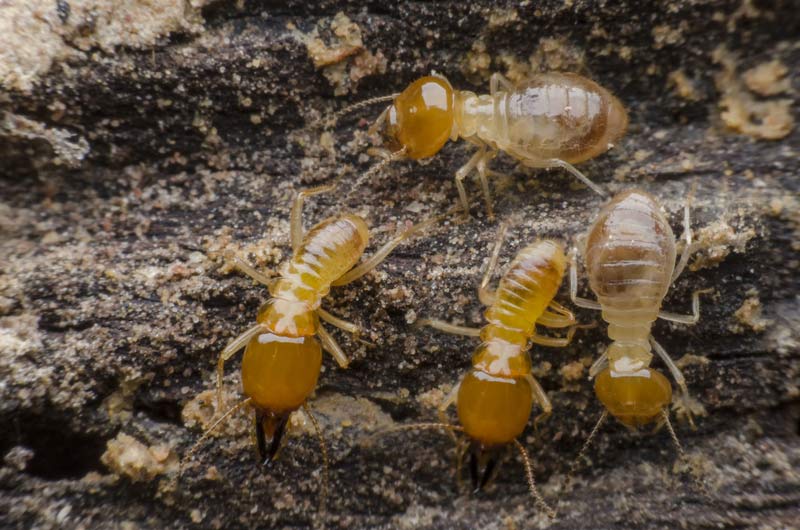Termite Exterminators: Manhattan, Brooklyn, and Queens

The Full Force Termite Exterminators’ Approach
IDENTIFICATION
We’ll look for signs of termites, and their entry points to the property will be determined.
EXTERMINATION
If termites are found, a licensed technician will treat your property with a solution that is best for your particular situation.
PROTECTION & PREVENTION
Full Force Pest Control will protect your property against future infestations with a customized plan.
Termites
Order Isoptra, ¼ – ½ in.
Termites hide from humans, but once inside, they’ll furtively destroy living spaces. They thrive in homes and yards and nobody thinks twice…until the damage is done and costly repairs are needed. Billions of dollars go into Termite damage control every year, making termites the most feared pest insect.
Termites are less than inch long and have soft, pale bodies. The King and Queen may reach over an inch. Flying Reproductives (Sexually mature termites) have two pairs of large wings. The winged termites are attracted to light and swarm around doors and windows. Their peak activity is in Spring. Flying termites mate in the summer, lose their wings, and become Kings and Queens to create new colonies. In some species the queen lays millions of eggs a year. The other termites are considered workers and soldiers and they keep the colonies operating with food and protection.
Every building structure is food for termites. Their diets consist of cellulose-based plant materials – organic fibers in plants and wood. Being Detritus feeders, they’ll eat through dead trees, drywall, plastic and paper. Some feed on living trees. Termites’ mouths tear through wood material. They’re capable of destroying furniture, bookshelves, books, and large infestation ruins the foundations.
Over two thousand termite species exist, but three major types are the most common household pests. The Eastern Subterranean termites, the Pacific Dampwood, termites and the Southeastern Drywood. Depending on climate and moisture conditions, these termites make colonies in wooden structures, rotting trees, soil and timber. Subterranean termites are found all through the United States. Dampwood and Drywood termites reside in the Southern regions.
Subterranean Termites
(Reticulitermes, Coptotermes and Heterotermes)
Subterranean termites have three castes with differing features. The workers are light-colored, wingless and six millimeters long. The reproductives are dark with two pairs of wings of equal length and the soldiers are wingless and have light bodies and longer dark heads with mandibles. Each colony has a primary queen that will lay tens of thousands of eggs in their lifetime, the reproductives will also lay eggs in established colonies.
Subterranean termites nest underground for moisture and eat most wood species, but prefer soft wood. They construct colonies in mounds of soil with intricate tunnel systems to collect food above ground. Damaged wood has soil or mud buildup in the tunnels of wood they eat. They feed with the wood grain and not across like Drywood termites.
Dampwood Termites
( Zootermopsis and Neotermes)
Dampwood termites are larger than common Subterranean termites. The winged termites, also known as Swarmers, can grow to be Twenty-five millimeters long. The soldiers and immature termites grow up to twenty millimeters. Dampwood termites live near the ground and eat damp, rotted wood from any source. They eat the grain and the damaged wood looks smooth. They create chambers in the wood for colonies and nesting.
They’re commonly found on the Pacific coast and in the Southwest Desert and Southern Florida. Keeping Dampwood Termites under control involves keeping moisture under control. Quickly addressing roofing and siding leaks, drainage, and plumbing issues will help keep an infestation under control.
Drywood Termites
(Cryptotermes and Incisitermes)
Drywood termites have castes, the reproductive ones are known as Alates. The alates and soldier termites and have two sets of wings. After swarming, they’ll shed their wings. This distinguishes them from Subterranean and Dampwood termites that often die with attached wings. The Drywood termites have a wide pronotum and large mandibles with teeth. They’re bigger than Subterranean colonies.
Drywood termites live in attics, and infest furniture and walls. They eat wood with little moisture and feed off the wood they’d colonized. The Reproductives create new colonies after mating. Warm weather and rainfalls bring out the swarms.
Drywood termites conserve water from their feces, creating dry, hexagonal pellets called Frass that they’ll push out of the tunnels. Finding these pellet mounds can signal an infestation, but they could’ve simply abandoned the colony. Professionals from Full Force Pest Control will help determine if their activity is ongoing. Our technicians will look over your home structure to recognize which species created the infestation.
